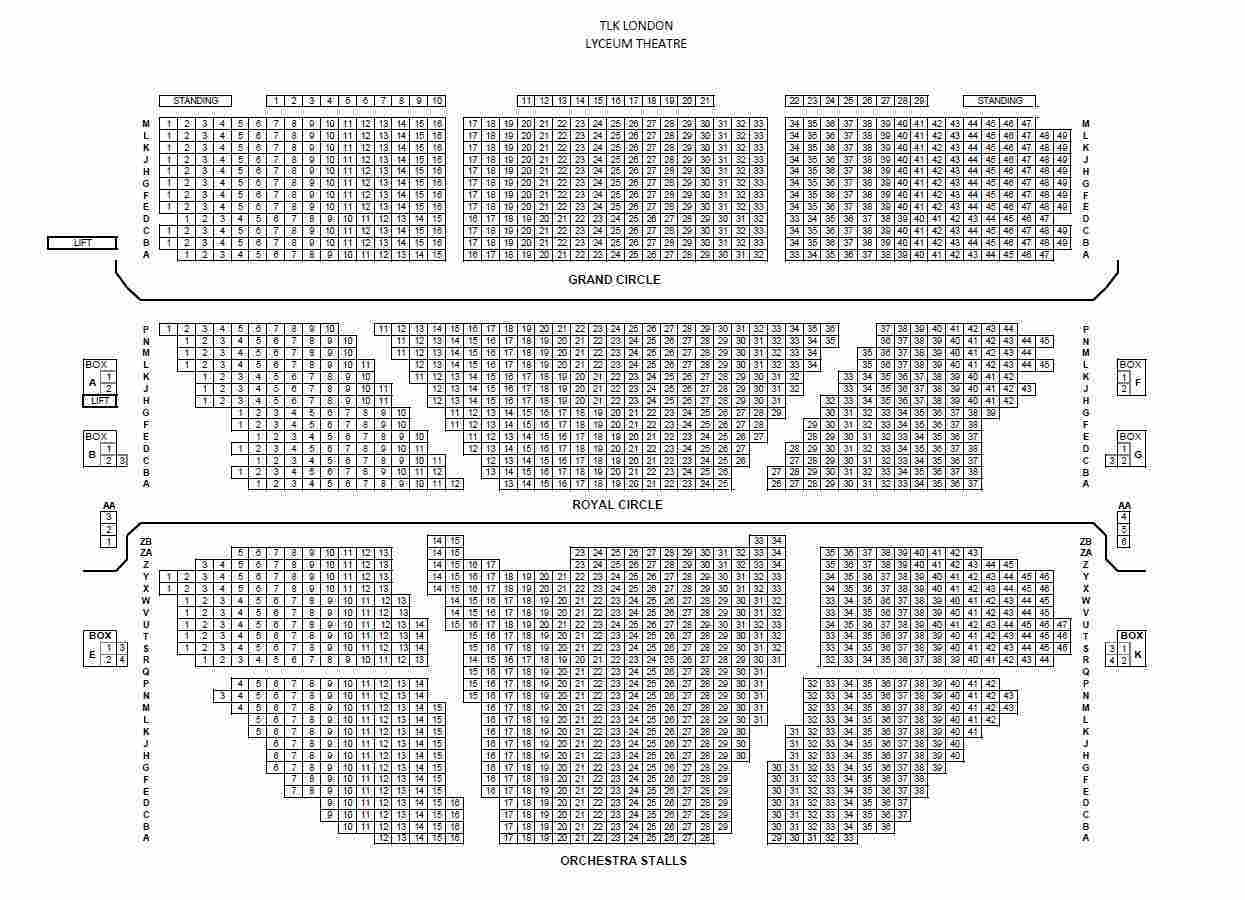THE LYCEUM THEATRE, LONDON
The Lyceum Theatre is a 2,000-seat West End theatre located in the City of Westminster, on Wellington Street, just off the Strand. There has been a theatre with this name in the locality since 1765, and the present site opened on 14 July 1834 to a design by Samuel Beazley. The building was unique in that it had a balcony overhanging the circle. It was built by the partnership of Peto & Grissell.
The present building retains Beazley's façade and grand portico, but the theatre behind is substantially to the 1904 design of Bertie Crewe, restored to theatrical use in 1996 by Holohan Architects, after a long period of use as a Mecca Ballroom.
Lyceum Theatre History
Lyceum Theatre : Early years
The Old Lyceum Theatre was first built in 1765 on an adjacent site, and in the late 18th century, musical entertainments were given by Charles Dibdin. Famed actor David Garrick also performed at the Lyceum. Between 1794 and 1809, the building was used as a circus, brought by Philip Astley when his amphitheatre was burned down at Westminster, and then a chapel, a concert room, and for the first London exhibition of waxworks displayed by Madame Tussaud in 1802.
The theatre became a "licensed" house in 1809, and until 1812 it was used for dramatic performances by the Drury Lane Company after the burning of their own theatre, until the erection of the new edifice. In 1816, Samuel Arnold rebuilt the house to a design by Beazley and opened it as "The English Opera House", but it was destroyed by fire in 1830. The house was famous as the first theatre in London to be lit by gas and for hosting the London première of Mozart's opera Cosi Fan Tutti. During this period, the "Sublime Society of Beef Steaks," which had been founded in 1735 by theatre manager Henry Rich, had its home at the theatre for over 50 years until 1867. The members, who never exceeded twenty-four in number, met every Saturday night to eat beefsteaks and drink port wine.
Lyceum Theatre : Present site
In 1834, the present house opened slightly to the west, with a frontage on Wellington Street, under the name "Theatre Royal Lyceum and English Opera House". The theatre was again designed by Beazley and cost £40,000. The new house championed English opera rather than the Italian operas that had played earlier in the century. Composer John Barnett produced a number of works in the first few years of the theatre, including The Mountain Sylph (1834), credited as the first modern English opera. It was followed by Fair Rosamund in 1837 and Farinelli in 1839 (both at the Theatre Royal, Drury Lane), and Blanche of Jersey here in 1840. In 1841–43, composer Michael Balfe managed the theatre and produced National Opera here, but the venture was ultimately unsuccessful. The house then became associated with adaptations of Charles Dickens's novels and Christmas books.For instance, an adaptation of Dickens' Martin Chuzzlewit ran for over 100 performances from 1844–45 here, a long run for the time.
The Lyceum was later managed by Madame Lucia Elizabeth Vestris and Charles James Mathews from 1847–55, who produced James Planché's "[fairy] extravaganzas" featuring spectacular stage effects. Tom Taylor's adaptation of A Tale of Two Cities, with Dickens himself as consultant, played in 1860, shortly after end of its serialisation and volume publication. Charles Fechter, who managed the theatre from 1863–67 also favored spectacular productions. In 1866, Dion Boucicault's The Long Strike (his adaptation of Elizabeth Gaskell's Manchester novels Mary Barton and Lizzie Leigh) was produced here. Ethel Lavenu, the mother and grandmother of actors Tyrone Power, Sr. and Tyrone Power performed in a number pieces at the theatre in the 1860s. W. S. Gilbert produced three plays here. In 1863, his first professional play, Uncle Baby, premièred. In 1867, he presented his Christmas pantomime, called Harlequin Cock Robin and Jenny Wren…, and in 1884, he produced the drama Comedy and Tragedy.
In 1889, the world's finest Italian dramatic tenor, Francesco Tamagno, appeared at the Lyceum, singing the leading role in the first London production of Giuseppe Verdi's opera Otello.
Lyceum Theatre : Irving years
Sir Henry Irving
Beginning in 1871, under manager Hezekiah Linthicum Bateman and his wife, Henry Irving appeared at the theatre in, among other things, many Shakespeare works. Irving began with the French melodrama The Bells, an instant hit in which he played the ghost-haunted burgomaster. The piece ran to sell-out crowds for 150 nights, which was an unusually long run at the time. Charles I, in 1872 was another hit, running for 180 nights. In 1874, Irving played Hamlet at the theatre, perhaps his greatest triumph, running for 200 nights. In 1878, after Bateman's death, Irving took over management of the theatre from his widow. The Builder, 28 September 1878 reported that there was a difference between Irving and Mrs. Bateman regarding the personnel of the company at the Lyceum. "Mr. Irving is said to have told Mrs. Bateman that he was resolved to have actors to act with him, and not dolls, otherwise he would no longer play at the Lyceum. The result was that Mrs. Bateman threw up the management of the theatre, and Mr. Irving takes her place." Mrs. Bateman became the manager of Sadler's Wells Theatre.
Ellen Terry as Katherine in Henry VIIIIrving continued to star in plays there, especially Shakespeare, until 1902, engaging co-star Ellen Terry for that entire period of 24 years.Bram Stoker worked between 1878 and 1898 as business manager of the theatre, and Irving was Stoker's real-life inspiration for the character Count Dracula in his 1897 novel, Dracula. Stoker hoped that Irving, with his dramatic, sweeping gestures, gentlemanly mannerisms, and speciality in playing villain roles, would play Dracula in the stage adaptation of his novel. However, Irving never agreed to appear in the stage version, although the play was produced at the Lyceum.
Irving and Terry began with Hamlet in 1878. Their 1879 production of The Merchant of Venice ran for an unusual 250 nights, and success followed success in the Shakespeare canon as well as in other major plays. Other celebrated productions included Much Ado About Nothing,[13] The Lady of Lyons by Edward George Bulwer-Lytton (1878), Romeo and Juliet, King Lear, The Lyons Mail by Charles Reade (1883), the immensely popular Faust by William Gorman Wills (1885, which even drew applications for reserved seats from foreigners), Macbeth (1888, with incidental music by Sir Arthur Sullivan), Henry VII (1892), Becket by Alfred Tennyson (1893), King Arthur by J. Comyns Carr, with incidental music by Sir Arthur Sullivan (1895),[15] Cymbeline (1896) and Victorien Sardou and Émile Moreau's play Madame Sans-Gêne (1897).
When Irving and Terry toured America, as they did several times beginning in 1883, the theatre played works with many famous actors including Johnston Forbes-Robertson, Mrs. Patrick Campbell, Sarah Bernhardt and Eleanora Duse. Martin Harvey, a pupil of Irving's played a season there in 1899. Benoît-Constant Coquelin appeared as Cyrano de Bergerac in the summer of 1898.
Lyceum Theatre : Later years
In 1904, the theatre was rebuilt and richly ornamented in rococo style by Bertie Crewe, retaining only the façade and portico of the original building. The theatre presented music hall and variety, in an attempt to compete with the Palace Theatre and the London Coliseum, but this was not a success, and the theatre soon returned to presenting drama. From 1909–38 the Melville Brothers ran a successful series of spectacular melodramas. In 1919, additional minor alterations to the theatre were made by Edward Jones. Between the wars, dramas played at the theatre for ten months each year, followed by Christmas pantomimes, including Queen of Hearts in 1938. The Lyceum was the last London theatre to continue the early practise of concluding pantomimes with a harlequinade, a free standing entertainment of slapstick clowning, juggling and tumbling. The tradition ended with the closure of the theatre in 1939.
In 1939, the London City Council bought the building, with plans to demolish it to make room for road improvement. The theatre closed that year with a landmark performance of Hamlet directed by Sir John Gielgud (Ellen Terry's great nephew). The road improvement plans collapsed, and after the war, in 1951, it was converted to a huge ballroom and reopened by Matthews and Sons, as the Lyceum Ballroom. Many big bands played here, including the Oscar Rabin Band which performed frequently. In the 1960s and 1970s, the theatre was used as a pop concert venue and for television broadcasts. The Grateful Dead, The Clash, Bob Marley & The Wailers, Led Zeppelin, The Who, Emerson, Lake & Palmer, Colosseum, U2, The Smiths and Culture Club all played here. Genesis filmed a performance there in May 1980 for broadcast on the Old Grey Whistle Test. This footage appears on the 2007 CD/DVD re-release of their 1980 album Duke.
Side of the Lyceum Theatre in 2006, with red The Lion King displays visible.A proposed redevelopment of Covent Garden by the GLC in 1968 saw the theatre under threat, together with the nearby Vaudeville, Garrick, Adelphi and Duchess theatres. An active campaign by Equity, the Musicians' Union, and theatre owners under the auspices of the Save London Theatres Campaign led to the abandonment of the scheme. In 1973, the theatre gained protection and was Grade II* listed as Interior despite adaptation and alteration for present ballroom use retains a substantial part of Crewe's work.
The theatre went dark in 1986, after the National Theatre's promenade performances (in 1985) of Bill Bryden's adaptation of the Mysteries trilogy. Brent Walker leased the theatre during this time but later gave up his lease, and in 1996 it was restored and reconverted into a theatre for large scale musicals or opera (with a suitably large orchestra pit) by Holohan Architects.
The theatre has been home to the musical version of The Lion King since 1999.
Lyceum Theatre Recent and present productions
Jesus Christ Superstar (19 November 1996 – 28 March 1998)
Oklahoma! (February 1999 – June 1999)
The Lion King (24 September 1999 – present)


